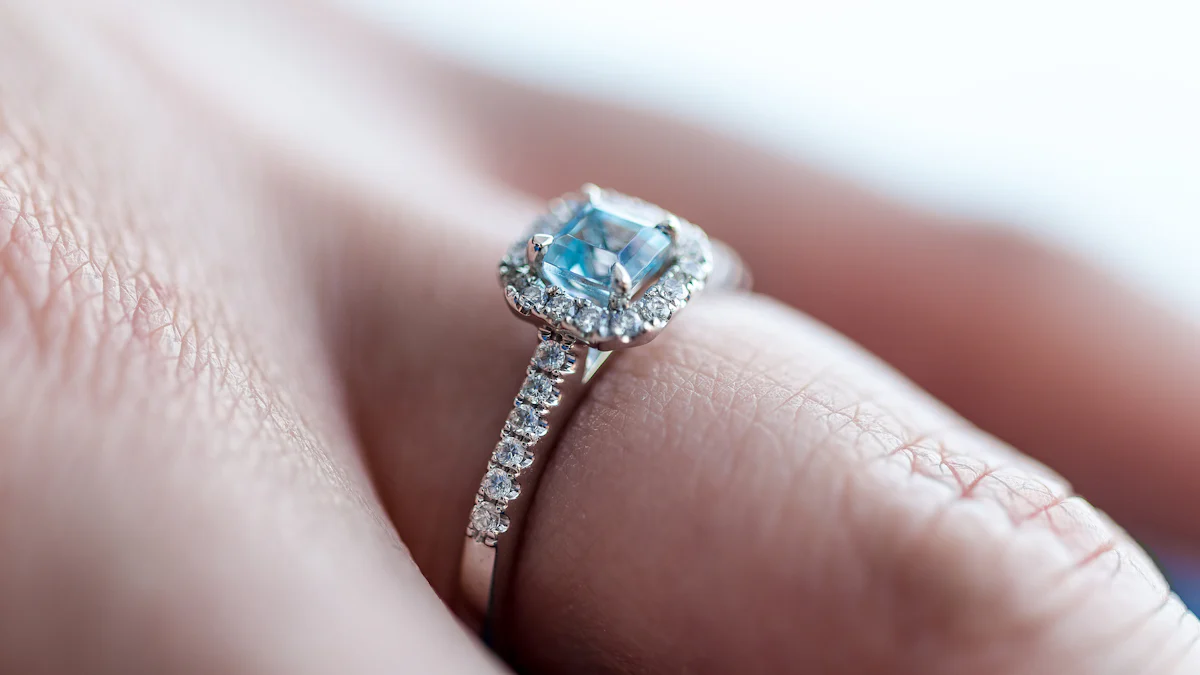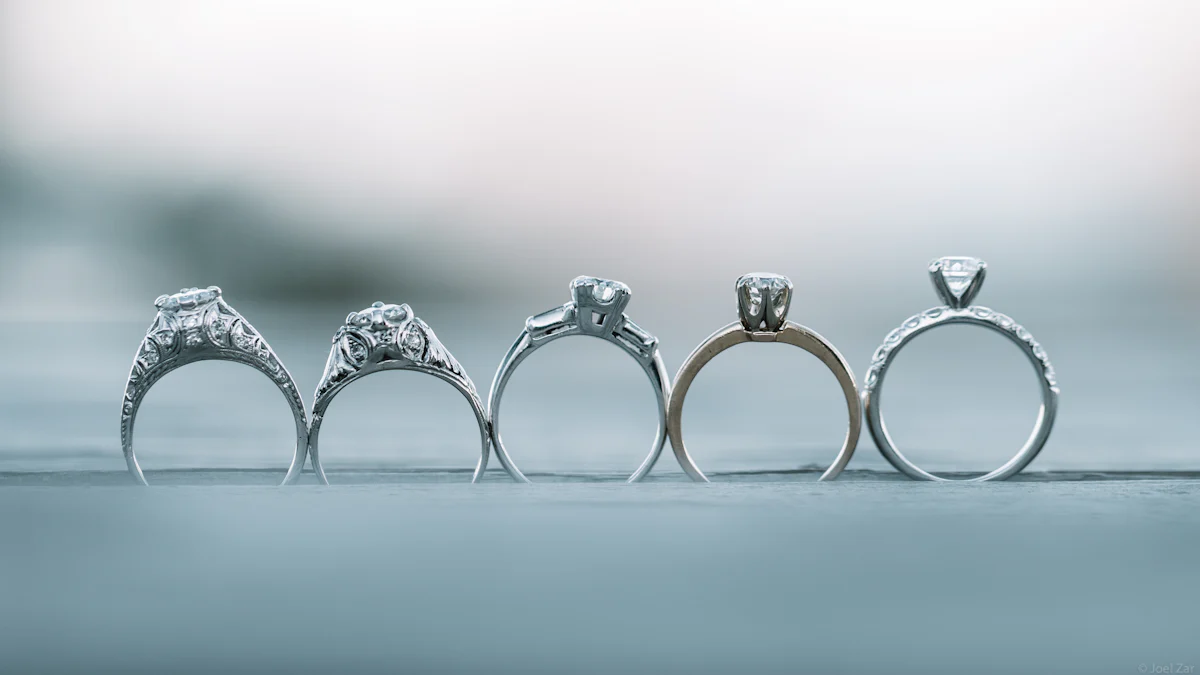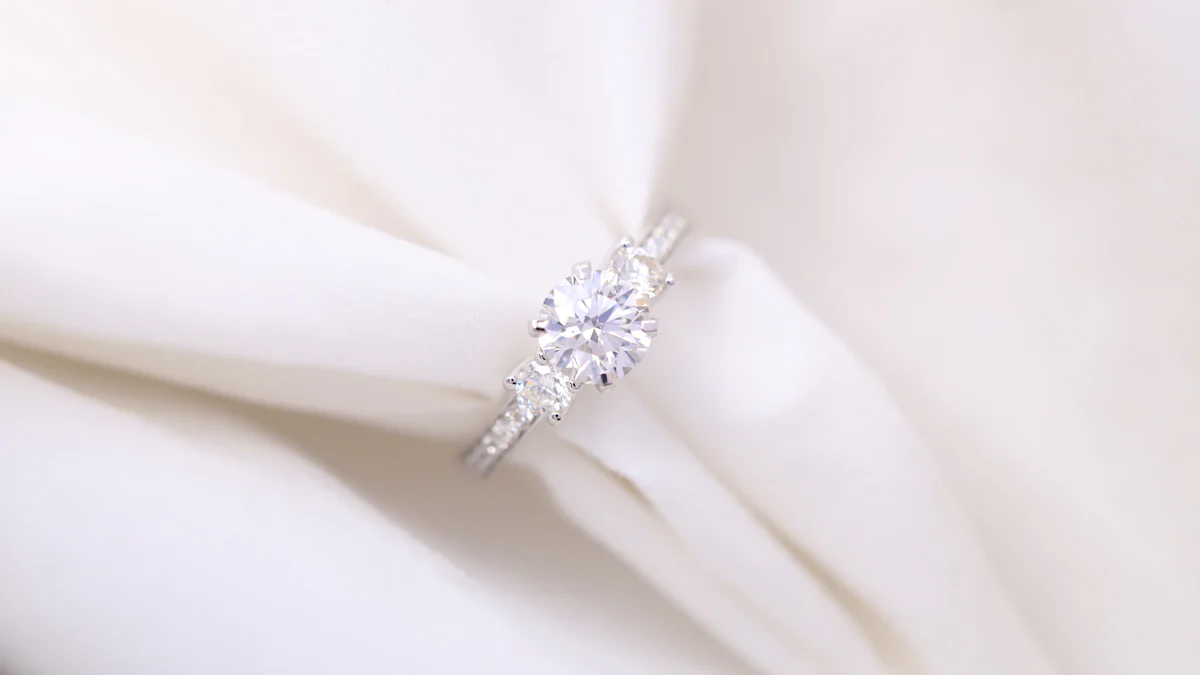Lab-grown vs Natural 2k Engagement Ring Comparison

Finding a 2k engagement ring with a 2-carat diamond may seem impossible, but lab-grown diamonds make it achievable. These diamonds offer the same brilliance and durability as natural ones while being significantly more affordable. A lab-grown 2-carat diamond engagement ring can cost as little as $1,750, compared to over $13,000 for a natural counterpart. This affordability allows you to stay within your budget without compromising on quality. Additionally, lab-grown diamonds are an ethical and sustainable choice, making them ideal for those seeking affordable engagement rings with a conscience.
Cost Comparison for Engagement Rings Under $2,000
When shopping for engagement rings under $2,000, understanding the price differences between lab-grown and natural diamonds is essential. The cost of a diamond depends on factors like size, quality, and origin. Let’s break down the pricing for both options to help you make an informed decision.
Price of Lab-grown Diamonds
Lab-grown diamonds offer a budget-friendly solution for those seeking a stunning 2k engagement ring. These diamonds are created in controlled environments, which significantly reduces production costs. As a result, you can find a 2-carat lab-grown diamond for as little as $1,750. This affordability allows you to focus on other aspects of the ring, such as the setting or design, without exceeding your budget.
Retailers often provide a wide range of engagement rings under $2,000 featuring lab-grown diamonds. These options ensure you don’t have to compromise on size or quality. Despite their lower price, lab-grown diamonds possess the same brilliance and durability as their natural counterparts, making them an excellent choice for cost-conscious buyers.
Price of Natural Diamonds
Natural diamonds, on the other hand, come with a much higher price tag. A 2-carat natural diamond with high-quality color and clarity typically costs between $13,000 and $14,000. In some cases, prices can soar to $30,000 or more, depending on the diamond’s rarity and characteristics. For those with a strict $2,000 budget, a natural diamond of this size is simply out of reach.
The high cost of natural diamonds stems from their rarity and the extensive mining process required to extract them. While they hold a certain allure due to their natural origin, their price makes them less accessible for buyers seeking affordable engagement rings under $2,000.
By comparing the prices of lab-grown and natural diamonds, it becomes clear that lab-grown options provide a more practical and attainable solution for a 2k engagement ring. They combine affordability with beauty, ensuring you get the most value for your investment.
Quality and Appearance of a Diamond Engagement Ring

When choosing a diamond engagement ring, understanding its quality and appearance is crucial. These factors determine the overall beauty and value of the ring. By comparing lab-grown vs natural diamond options, you can make an informed decision that aligns with your preferences.
The 4 C’s of Lab-grown vs Natural Diamonds
The 4 C’s—cut, color, clarity, and carat—serve as the universal standard for evaluating diamonds. Both lab-grown and natural diamonds are graded using these criteria, ensuring consistency in quality assessment.
-
Cut: The cut determines how well a diamond reflects light. Lab-grown diamonds often feature precise cuts due to their controlled production process. Natural diamonds, shaped by nature, may vary slightly in cut quality.
-
Color: Both types of diamonds range from colorless to light yellow. Lab-grown diamonds frequently achieve higher color grades because their creation process allows for better control over impurities.
-
Clarity: Clarity measures the presence of inclusions or blemishes. Lab-grown diamonds tend to have fewer inclusions compared to natural diamonds. This difference arises from the controlled environment in which lab-grown diamonds are produced.
-
Carat: Carat refers to the weight of the diamond. Both lab-grown and natural diamonds offer a wide range of carat sizes. However, lab-grown diamonds provide larger carat options at a lower price point, making them more accessible for budget-conscious buyers.
By evaluating the 4 C’s, you can see that lab-grown diamonds often excel in clarity and color, while natural diamonds hold their own in terms of rarity and uniqueness.
Visual Differences Between Lab-grown and Natural Diamonds
To the naked eye, lab-grown and natural diamonds appear nearly identical. Both possess the same optical brilliance and sparkle, making it difficult to distinguish between the two without specialized equipment.
-
Brilliance and Fire: Lab-grown diamonds exhibit the same level of brilliance and fire as natural diamonds. Their ability to refract light remains consistent, ensuring a dazzling appearance in any setting.
-
Inclusions and Imperfections: Natural diamonds may contain unique inclusions formed over millions of years. These imperfections add character but can affect clarity. Lab-grown diamonds, created in controlled environments, typically have fewer inclusions, resulting in a cleaner look.
-
Certification: Both types of diamonds come with certifications from reputable gemological institutes. These certifications confirm their quality and authenticity, providing peace of mind when purchasing your diamond engagement ring.
Ultimately, the visual differences between lab-grown vs natural diamond options are minimal. Both offer stunning beauty, but lab-grown diamonds often provide a more flawless appearance due to their production process.
Ethical and Environmental Impact of Lab-grown vs Natural Diamonds

When selecting an engagement ring, understanding the ethical and environmental implications of your choice is essential. Both lab-grown and natural diamonds have unique impacts on the world, and knowing these differences can help you make a more informed decision.
Ethical Considerations for Engagement Rings
The ethical concerns surrounding diamonds often stem from their origins. Natural diamonds, while beautiful, sometimes come with a troubling history. In certain regions, mining operations have been linked to unsafe working conditions, unfair wages, and even human rights violations. Although many well-regulated mines have improved their practices, less regulated ones may still exploit workers and harm local communities.
Lab-grown diamonds, on the other hand, generally offer a more ethical alternative. These diamonds are created in controlled environments, ensuring fair wages and safer working conditions for employees. Workers in diamond labs benefit from advanced safety protocols and regulated environments, which reduce the risks associated with traditional mining. However, not all lab-grown diamonds are created equally. Choosing diamonds from companies committed to ethical standards ensures that your purchase aligns with your values.
Expert Insight: "The lab-grown diamond industry generally offers fairer and safer working conditions compared to some mining operations. Workers in diamond labs benefit from regulated environments, advanced safety protocols, and fair wages."
By prioritizing ethically sourced diamonds, whether lab-grown or natural, you can ensure your engagement ring reflects your commitment to fairness and responsibility.
Environmental Impact of Lab-grown vs Natural Diamonds
The environmental impact of diamonds is another critical factor to consider. Natural diamonds require extensive mining, which can lead to deforestation, habitat destruction, and significant carbon emissions. The extraction process often disrupts ecosystems and consumes vast amounts of water and energy, leaving a lasting environmental footprint.
Lab-grown diamonds are often seen as a more sustainable option. These diamonds eliminate the need for mining, preserving natural landscapes and reducing ecological damage. However, producing lab-grown diamonds requires substantial energy, with estimates ranging from 250kWh to 750kWh per carat. This energy consumption can contribute to carbon emissions, especially when fossil fuels power the production process. Fortunately, some companies now offer carbon-neutral lab-grown diamonds, which use renewable energy sources to minimize their environmental impact.
Expert Insight: "While lab-grown diamonds are generally more sustainable and ethical than mined diamonds, not all lab diamonds are created equal. A disadvantage of lab diamonds is that a huge amount of power is required to enable their growth – between 250kWh and 750kWh. But carbon-neutral lab diamonds do exist."
To make an environmentally conscious choice, look for diamonds with certifications that verify their eco-friendly production methods. Whether you choose lab-grown or natural diamonds, selecting options with traceable origins and sustainable practices can help protect the planet.
Durability and Longevity of Lab-grown vs Natural Diamonds
When investing in an engagement ring, durability and longevity are crucial factors to consider. Both lab-grown and natural diamonds excel in these areas, offering exceptional hardness and resilience. Understanding their performance in daily wear and maintenance can help you make the best choice for your lifestyle.
Hardness and Wear of Lab-grown vs Natural Diamonds
Lab-grown and natural diamonds share identical physical properties, making them equally durable. Both score a perfect 10 on the Mohs scale of hardness, which means they resist scratches better than any other material on Earth. This hardness ensures that your diamond engagement ring maintains its brilliance even after years of wear.
Scientific Research Findings: Studies confirm that lab-grown diamonds perform similarly to natural diamonds in the Vickers Hardness Test. In some cases, lab-grown diamonds exhibit higher fracture toughness, offering greater resistance to breakage.
The controlled environment in which lab-grown diamonds are created allows for precision crafting. This process often results in diamonds with enhanced toughness, reducing the likelihood of chipping or cracking. Natural diamonds, formed over millions of years, also possess remarkable durability, making them a timeless choice for engagement rings.
Whether you choose a lab-grown or natural diamond, both options provide the strength needed to withstand daily activities. Their unmatched hardness ensures that your ring remains a symbol of enduring love and commitment.
Maintenance and Care for Lab-grown vs Natural Diamonds
Proper maintenance is essential to preserve the beauty of your diamond engagement ring. Both lab-grown and natural diamonds require similar care routines to keep them looking their best.
-
Cleaning: Regular cleaning helps maintain the sparkle of your diamond. Use a soft brush and a solution of mild soap and warm water to gently remove dirt and oils. Avoid harsh chemicals, as they can damage the setting.
-
Storage: Store your ring in a separate compartment or a soft pouch to prevent scratches. Diamonds can scratch other jewelry, so keeping them apart ensures their longevity.
-
Inspection: Periodically inspect your ring for loose settings or damage. Professional jewelers can tighten prongs and check for wear, ensuring your diamond stays secure.
-
Avoid Impact: While diamonds are incredibly hard, they are not indestructible. Avoid wearing your ring during activities that could expose it to strong impacts, such as heavy lifting or sports.
Expert Tip: "Lab-grown diamonds, like natural ones, require regular care to maintain their brilliance. Simple cleaning and proper storage can significantly extend the life of your engagement ring."
By following these care tips, you can ensure that your diamond engagement ring remains as stunning as the day you received it. Both lab-grown and natural diamonds offer exceptional longevity, making them a lasting symbol of your love story.
Certification and Value Retention of a 2k Engagement Ring
Importance of Certification for Lab-grown and Natural Diamonds
Certification plays a vital role when purchasing an engagement ring. It ensures the authenticity and quality of the diamond, whether it is lab-grown or natural. Reputable gemological institutes like the GIA (Gemological Institute of America) and IGI (International Gemological Institute) provide certifications for both types of diamonds. These certifications detail the diamond's cut, color, clarity, and carat weight, offering you confidence in your purchase.
For lab-grown diamonds, certification confirms that the diamond was created in a controlled environment and meets industry standards. This transparency allows you to verify the ethical sourcing and quality of the diamond. On the other hand, natural diamonds also come with certifications that validate their origin and characteristics. These documents often highlight the rarity and uniqueness of natural diamonds, which many buyers value.
When shopping for a 2k engagement ring, always request a certification. It protects your investment and ensures that the diamond you choose aligns with your expectations. Certified diamonds, whether lab-grown or natural, provide peace of mind and guarantee that you are getting what you pay for.
Value Retention of Lab-grown vs Natural Diamonds
Value retention is an important consideration when selecting a diamond for your engagement ring. Natural diamonds tend to hold their value better over time due to their rarity and historical significance. Their limited supply and natural formation process make them a desirable choice for those who view diamonds as a long-term investment.
In contrast, lab-grown diamonds are more affordable but may not retain their value as well. The controlled production process of lab-grown diamonds allows for a steady supply, which can impact their resale value. While they offer exceptional beauty and ethical advantages, they lack the same rarity and symbolic meaning as natural diamonds.
Expert Insight: "Lab-grown diamonds provide a cost-effective and ethical option, but their value may not appreciate over time like natural diamonds."
If value retention is a priority for you, natural diamonds might be the better choice. However, if affordability, ethics, and sustainability matter more, lab-grown diamonds offer significant advantages. Ultimately, the decision depends on your personal values and long-term goals.
Lab-grown diamonds offer a compelling choice for a 2k engagement ring. They combine affordability, ethical sourcing, and environmental sustainability, making them ideal for those seeking affordable engagement rings without compromising on quality. Natural diamonds, while more expensive, appeal to those valuing rarity and higher resale potential. Your decision should align with your budget, values, and long-term goals. Whether you prioritize cost-effectiveness or the timeless allure of natural diamonds, both options provide stunning rings that symbolize love and commitment.
FAQ
What exactly is a lab diamond?
Lab-grown diamonds are real diamonds. They share the same chemical composition, optical properties, and physical features as natural diamonds. These diamonds are created in controlled environments that replicate the natural diamond formation process. If you’re considering a lab-grown diamond, understanding its creation and benefits can help you decide if it’s the right choice for your engagement ring.
Are lab-grown diamonds as durable as natural diamonds?
Yes, lab-grown diamonds are just as durable as natural diamonds. Both score a perfect 10 on the Mohs scale of hardness, which means they resist scratches and wear exceptionally well. This durability ensures that your diamond engagement ring will maintain its brilliance for years, regardless of whether it’s lab-grown or natural.
Can you tell the difference between lab-grown and natural diamonds?
To the naked eye, lab-grown and natural diamonds look identical. Both exhibit the same brilliance, fire, and sparkle. Only specialized equipment can detect the subtle differences in their growth patterns. For most buyers, the visual appearance of lab-grown diamonds matches that of natural ones, making them an excellent alternative.
Do lab-grown diamonds come with certifications?
Yes, lab-grown diamonds come with certifications from reputable gemological institutes like the GIA (Gemological Institute of America) and IGI (International Gemological Institute). These certifications detail the diamond’s cut, color, clarity, and carat weight. Always request a certification to ensure the quality and authenticity of your diamond.
Are lab-grown diamonds more affordable than natural diamonds?
Lab-grown diamonds are significantly more affordable than natural diamonds. A 2-carat lab-grown diamond can cost as little as $1,750, while a natural diamond of the same size often exceeds $13,000. This affordability makes lab-grown diamonds a practical choice for those seeking high-quality engagement rings on a budget.
Do lab-grown diamonds hold their value over time?
Lab-grown diamonds typically do not retain their value as well as natural diamonds. Natural diamonds are rarer and have historical significance, which contributes to their higher resale value. Lab-grown diamonds, while more affordable and ethical, may not appreciate in value due to their steady supply.
Are lab-grown diamonds ethical and environmentally friendly?
Lab-grown diamonds are generally more ethical and environmentally friendly than natural diamonds. They eliminate the need for mining, which reduces habitat destruction and carbon emissions. However, producing lab-grown diamonds requires significant energy. Choosing diamonds from companies that use renewable energy can further minimize environmental impact.
Can I find a 2-carat engagement ring under $2,000?
Yes, you can find a 2-carat engagement ring under $2,000 if you choose a lab-grown diamond. These diamonds offer the same brilliance and durability as natural ones but at a fraction of the cost. Many retailers provide a variety of affordable options featuring lab-grown diamonds.
How should I care for my diamond engagement ring?
Caring for your diamond engagement ring involves regular cleaning, proper storage, and periodic inspections. Use a soft brush and mild soap to clean your ring. Store it in a separate compartment to avoid scratches. Inspect the setting regularly to ensure the diamond remains secure. These steps will keep your ring looking stunning for years.
Why should I choose a lab-grown diamond over a natural diamond?
Choosing a lab-grown diamond offers several advantages. They are more affordable, ethical, and environmentally sustainable. Lab-grown diamonds also provide larger carat sizes and higher clarity grades at lower prices. If you value cost-effectiveness and sustainability, a lab-grown diamond is an excellent choice for your engagement ring.
See Also
Understanding The Cost Of A 2 Carat Lab Diamond
Comparing Prices For Lab-Grown Tennis Bracelets
Reviewing 10 Carat Lab-Grown Tennis Bracelets

